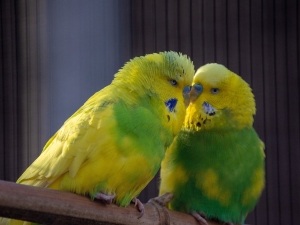
A change in your bird’s behavior will make any bird owner concerned, this includes any twitching of any kind and includes a twitching of the bird’s head.
This is a guide looking into why your budgie may be twitching its head.
Table of Contents
Budgie twitching head:
If your bird is suffering from a significant change then the bird needs to be examined and treated as soon as possible. A twitching of the bird’s head is a significant change
A twitching of the head usually means that the bird is having a partial seizure. A partial seizure is a seizure that affects the bird’s head, wing, or leg. These types of seizures happen when there is abnormal electrical activity in one area of the brain.
A partial seizure is different from a generalized seizure as generalized seizures develop when there is abnormal electrical activity in both the left and right side of the bird’s brain
What causes it:
Just as in humans, a variety of things can cause seizures in birds, these include but are not limited to the ingestion of poisonous plants, exposure to pesticides, exposure to tobacco, trauma, dehydration, early-stage liver disease, malnutrition, and overheating.
Budgies can also start seizing if a tumor in the bird’s body presses against certain parts of the bird’s brain, organs, or spine causing the bird’s head to twitch.
Tumors are common in birds who eat a predominantly seed diet.
What to do:
The best thing that you can do for your seizing bird is to quickly take the bird to the nearest vet.
Try your best not to delay taking the bird to the vet and having it treated, delaying can have a negative effect on the bird’s health.
Birds, and all animals for that matter, will do their best to keep from showing signs of being sick, by the time you see signs of the bird being ill the bird has likely been very ill for a while and can’t hide the signs any longer.
You’d need to transport the bird appropriately to keep the bird from getting worse on the way to the vet.
Do this by carefully picking the bird up and putting it in a small box to keep it from moving around too much on the way.
The vet will be able to calm the bird down and get it out of the seizure, calming the bird may entail keeping the bird in an isolated, quiet, and warm environment as well as giving the bird intravenous fluids to hydrate it.
Diazepam may also be given to the bird to calm it down.
Once you get the bird back home from the vet it is recommended that you keep the bird somewhere quiet and in a small cage that has padding at the bottom
You can keep your bird from seizing again by making sure that it isn’t exposed to toxic environments and materials like tobacco, pesticides, or poisonous plants, isn’t overheating, isn’t dehydrated, and isn’t malnourished.
Avoid trying to self-diagnose the bird and avoid trying to treat the bird yourself, this can sometimes only make the situation worse for the bird.
If you enjoyed this article then you may also be interested in other budgie-related articles. Here are some articles that you may be interested in: Budgie Twitching Wings, Bald Budgie Vent, Why Does My Budgie Bite When I Pet Him?, What To Do With Unwanted Budgie Eggs, How To Stop Budgie From Laying Eggs

